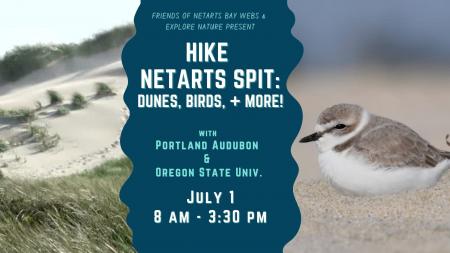Park rangers will be on hand to help share the story of this park and how it is changing. “The spit is a very dynamic place and ecosystem! The farther you walk down, the more immersed you get in the beach, ocean, and dunes,” says Chrissy Smith, Executive Director of Friends of Netarts Bay. “Just a month ago, with Portland Audubon’s guidance, we found snowy plover tracks and nest scrapes. Snowy plovers are listed as a threatened species. Portland Audubon has been recruiting community volunteers to help look for birds and nests. Finding evidence of these birds on the spit is exciting since there has not been a documented nest for many years.”
Researchers from OSU are also mapping different beach grasses growing on Oregon Dunes. They will also be joining us to talk about the native and nonnative beachgrasses, why the type of beachgrass matters, and what you can do to help scientists learn more about how they are spreading and growing. “Mapping each of the beachgrasses, which differ in several important key traits, is essential to understanding how they will affect dune functions and services, such as dune shape, coastal protection, and species diversity across Oregon,” says Risa Askerooth, graduate student researcher at OSU.
Risa continues, “You likely wouldn’t be able to recognize these dunes 100 years ago, since invasive beachgrasses have changed them so much. These beachgrasses, which were intentionally planted, are causing dramatic changes by stabilizing sand, improving protection for coastlines, and decreasing habitat for some native species.”
It is ~6 miles to the end of spit (12 miles round trip) and participants should expect to spend a full day exploring and hiking. If you are unsure if you want to commit to the full hike, Friends of Netarts Bay WEBS and partners will plan a few stops and offer the option to head back with volunteers to help you get to your cars.
Join us on this beach journey, learn about plover and beachgrass monitoring efforts, and explore the spit and how it is changing over time!
Date and time: July 1 from 8 am to ~3:30 pm
What to bring: Comfortable walking shoes, water, lunch, and snacks are a must! Binoculars are highly encouraged as a strong focus will be placed on birds! The climate can change quickly along the coast, ranging from warm to cool and breezy, so please bring the gear you need to stay comfortable.
Difficulty: Moderate + due to the length and challenges of walking on soft sands and wet sand. Participants can opt to join for a portion of this event. This event will take place outdoors. If bad weather develops, an alternate plan will be communicated to the registered participants.
Registration Required: Find the event registration list at www.netartsbaywebs.org/events
Cost: There is no cost to attend this program. Donations are appreciated. From June 15 to September 15, all contributions will be matched by the Charles A. Becker Foundation in support of our organization and programs. Learn more about the Friends of Netarts Bay WEBS matching gift challenge on our website www.netartsbaywebs.org.
An Explore Nature Partnership Cross-listed Event
Questions? Contact director@netartsbaywebs.org
